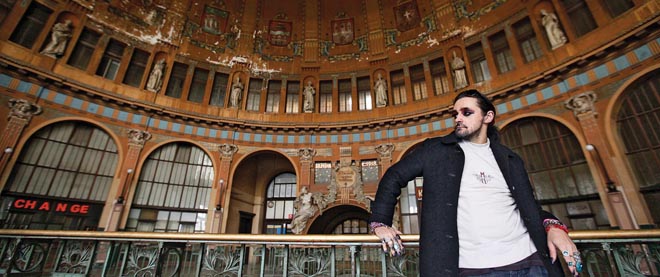Poorism, the new tourism
Travellers help the homeless by signing up for tours of the rougher side of town
Petr Josek Snr/Reuters
Share

His thick black eyeliner smudged and long dirty-blond hair in a ponytail, Karim holds a yellow umbrella high in the air as he walks through an unlit park in downtown Prague. He points to a group of men, barely visible in the dark. Heroin addicts about to shoot up, he explains to the group of tourists following him. After turning their attention to a few prostitutes on a corner, Karim opens up about his experience of living on and off the streets for more than 20 years.
Since August, the homeless transsexual and former prostitute has been leading one of the hottest tours of Prague. Similar tours, led by homeless or once-homeless guides, have popped up in London, Amsterdam and San Francisco. Billed as alternative views of the cities, they have been praised for converting tourist dollars into employment for homeless people and criticized for turning homelessness into a tourist attraction.
The past decade saw an explosion of poverty tourism in developing nations, with visitors traipsing through the slums of Mumbai or the favelas of Rio de Janeiro. Now it seems that poorism, as critics call it, has found a market in industrialized nations.
Karim’s tour is one of six offered by Pragulic, a non-profit group whose frontline includes five tour guides with varied experiences of homelessness, as well as translators who cater to English, German and even Vietnamese tourists. Each tour reflects the experiences of the guide; whether it’s visiting the dumpsters where one of them often forages for food, or touring a suburb where another shares his tips on finding a place to sleep.
“At the beginning we got some negative responses, saying that we were running some kind of zoo by taking people to watch another group in need,” says Pragulic co-founder Tereza Jurecková. She sees the tours as a bridge between the general public and the homeless, offering tourists a comfortable excursion into the “kind of life that most people are often very afraid to talk about or afraid to see.”
Pragulic guides take home half the ticket price from each tour, or about $5 for every tourist. The rest goes toward ongoing training and to provide more services to the homeless. Demand has been higher than expected among tourists and Czech nationals, and Jurecková says they are a success because the tours allow people to “experience how homeless live.”
It’s not just authenticity drawing tourists to the seedy side of cities, says Ballu Thakur, who teaches a class on trends in tourism at George Brown College in Toronto. Sometimes it’s about “pure gawking,” the kind of voyeurism where people end the tour gushing, “Oh my gosh, am I glad that I don’t live in this kind of place.” He points to dozens of hurricane-themed bus tours that run through the Lower Ninth Ward in New Orleans, where tourists jostle each other for the perfect snapshot of hurricane Katrina’s destruction. “That’s where I kind of say—are you kidding me?”
But poverty tours are an easy way to engage with a complex social issue, says Thakur. It appeals to those who think, “I’m not the granola-eating, Birkenstock-wearing activist, but I still want to make a difference. How do I do it? Let me do it the safe way.”
That was exactly what Union Gospel Mission had in mind this fall when it offered guided tours of Vancouver’s Downtown Eastside. Part of Homelessness Action Week, they brought more than 300 people through one of the poorest neighbourhoods in Canada.
“It’s like walking, in certain parts, through someone’s living room,” says organizer Keela Keeping about the tours, which were led by community members. “It kind of turns everything on its head. Instead of it being, ‘Oh, you poor people that don’t have anything to offer,’ ’’ she says, “It’s: ‘You’re the experts now. You’re going to teach us.’ ”
The tours were a success, but she hesitates at the idea of running them year round, or opening them to tourists. It might have more appeal in 10 years if the neighbourhood has tackled some of its poverty issues. Then the tours wouldn’t be about showcasing problems, they would be about solutions, a kind of, “Here’s how we did it—here’s what you can take back to your city.”